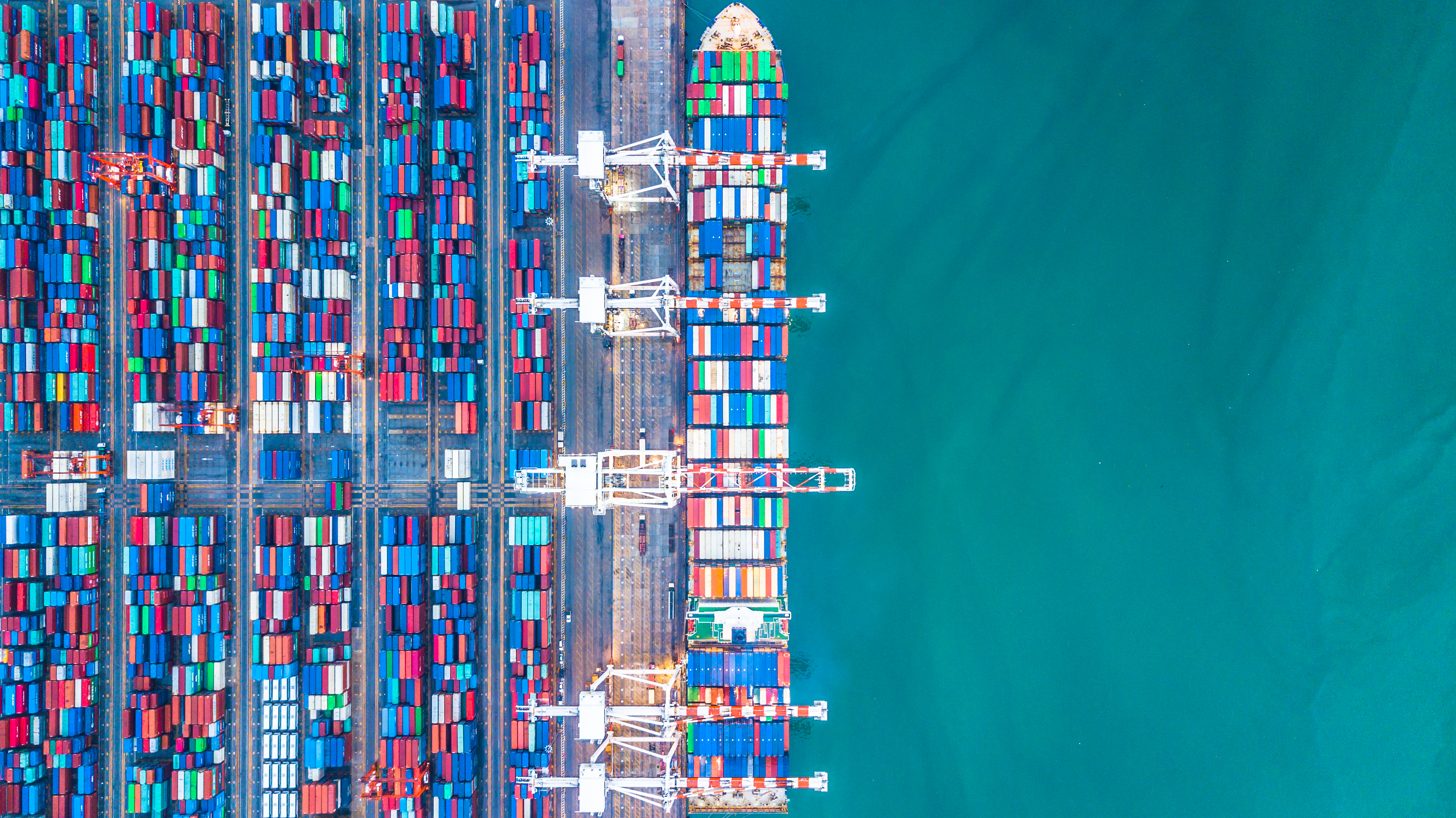
In 2024, bringing inflation under control was not enough to fully restore confidence, particularly in Europe, where weak demand weighed on road transport prices. Sea and air freight rates have held up better, under the influence of geopolitical factors that are shaking up the supply and demand logic.
The global economy grew in 2024 at a similar pace to 2023, but still with large geographical disparities. US growth is rather higher than expected, fuelled by the consumption of goods and services. On the other hand, the European economy is struggling in the face of great difficulties, suffering in particular from the failure of its historical driving force, Germany.
Price increases have continued to slow, but in a gloomy economic context, households and businesses remain cautious in their spending and investments. China is still growing at a rate well above the world average, while suffering from weakening demand from the West and particularly from Europe, while hopes of seeing domestic demand take over are not materializing. World trade volumes are growing, slightly below the World Trade Organization (WTO) forecast.
This lull did not prevent some disruption in supply chains. Unlike 2022, it is not an explosion in demand that is at stake. In 2024, the main difficulties have been related to the attacks of Houthi rebels in the Red Sea, which forced shipping companies to avoid the Suez Canal, at least temporarily disorganising logistics patterns. On the other hand, several events induced by climate change have, on an occasional basis, also caused disruptions to operating conditions in ports, airports or major global logistics centres.
1/ Growth: European disappointment
According to the OECD's preliminary economic forecasts published in December 2024, global gross domestic product is expected to have grown by 3.2% in 2024. This growth rate, 0.2 points lower than the 2013-2019 average, is stable compared to 2023, and slightly higher than the forecasts at the beginning of the year.
Unexpected good news came from the US economy, which recorded significantly better-than-expected results, with GDP growth expected to be 2.8% in 2024, compared to the 2.1% announced by the OECD in February 2024. India and China’s results also came through above expectations, even though their GDP growth slowed compared to 2023.
Europe is also doing slightly better, with growth expected to be 0.8% against 0.6% forecast. This result is nonetheless disappointing, with the eurozone still lagging significantly behind the world's other major economies. In 2024, it continued to suffer from the weakening of Germany, which has been the powerhouse of the European economy for decades. The country is about to experience its second consecutive year of recession (-0.1%, after -0.3% in 2023). According to the European Commission's autumn forecast, France will be above the Eurozone average with +1.1% and Italy slightly below at +0.7%. Spain, on the other hand, continues on a much higher than average growth curve with +3%. Among the major European markets, Poland is also making a significant rebound with +3% expected in 2024, after some difficult months given its particular exposure to the consequences of the Russian-Ukrainian conflict.
Beyond these recent developments, the long-term trajectory of the European economy is worrying. In documenting the decline, the Draghi report, published last September, had the effect of a thunderbolt. "However, EU economic growth has been persistently slower than in the US over the past two decades, while China has been rapidly catching up. The EU-US gap in the level of GDP at 2015 prices has gradually widened from slightly more than 15% in 2002 to 30% in 2023, while on a purchasing power parity (PPP) basis a gap of 12% has emerged. The gap has widened less on per capita basis as the US has seen faster population growth, but it is still significant: in PPP terms, it has risen from 31% in 2002 to 34% today," the report said. For the former president of the European Central Bank, author of the report, this drop is linked to "a weakening productivity growth", which calls into question Europe's ability to achieve its ambitions in terms of "social inclusion, carbon neutrality and increasing its geopolitical importance". What the causes of Europe falling so far behind are, as well as the report's recommendations for remedying them, are quite widely subject to debate. On the other hand, it is clear that the new European Commission has made European competitiveness one of its strategic priorities.
2/ Inflation: laborious control
The evolution of inflation remains an issue that reveals the specific challenges of each of the world's major economies.
The lull continued on this front in Europe and the United States in 2024, leading central banks to ease the monetary tightening policy they had put in place to stem the post-Covid overheating. However, this control remains fragile, as shown by the small rebound observed at the end of the year, and above all, on both sides of the Atlantic, the objective of an annual inflation rate of 2% has still not been achieved.
The US Central Bank (Fed) has also been very clear: on 18 December, it did announce a further quarter-point cut in its key interest rates, bringing them back to a range of 4.25% to 4.50%, but at the same time it declared that it "would be prepared to adjust the stance of monetary policy as appropriate if risks emerge that could impede the attainment of the Committee's goals". An announcement that has cooled financial markets, and also shows that the Fed is not totally reassured by the current and potential trajectory of the US economy.
The European Central Bank (ECB) also made a further quarter-point cut in its three key interest rates on 12 December. The risk of inflation slipping again seems lower than in the United States. However, the path to the 2% threshold is slowed by the impact of the inflationary surge of 2022-2023 on wages and prices in certain sectors, with a time lag.
China, finally, is fighting against the opposing trend, namely the risk of deflation, which is a sign of the country's economic difficulties. The phenomenon was very noticeable in 2023, particularly in the last quarter. In 2024, only January showed a decline, down 0.8%. Inflation then fluctuated between +0.1% and +0.7% depending on the month, but it is obvious that the market remains very cautious, both in terms of consumption and investments. China has also set up a series of stimulus measures in the fall of 2024. "In 2024, facing the challenges posed by domestic and international situations, China responded by taking a series of measures, thus achieving the major economic and social development goals for the year (…). As 2025 will see the conclusion of the country's 14th Five-Year Plan (2021-2025), it is necessary to carry out macroeconomic policies that are more proactive and impactful," Chinese President Xi Jinping announced in a speech on December 31.
3/ Manufacturing production still boosted by China
Global manufacturing output grew by 2.3% year-on-year in the third quarter of 2024. A performance similar to that of the second quarter and higher than that of the first quarter (+1.5%).
China, the leading producer with a market share of 27%, is further consolidating its dominance with growth of 5.9% in Q3 2024, after an increase of 6.6% in Q2 and 5.2% in Q1. Conversely, North America and Europe, which have a global market share of 19.2% and 22.7%, respectively, both recorded three quarters of decline in manufacturing output.

Source: Quarterly Report Q3 2024, United Nations Industrial Development Organization
Analysis by the type of industry shows a much more dynamic evolution of industries classified in the "medium-high" and "high-tech" categories, compared to other manufacturing sectors.

Source: Quarterly Report Q3 2024, United Nations Industrial Development Organization
4/ World trade
According to data from the World Trade Organization (WTO), global goods trade in value grew by 4.3% year-on-year in the third quarter of 2024, representing "a significant improvement from the 1.8% increase seen in Q2 and the 1.4% contraction observed in Q1."
At the same time, the volume of world merchandise trade increased by 1.1% quarterly and by 3.3% year-on-year in T3 2024, on a seasonally adjusted basis, "marking the fourth consecutive quarter of moderate trade expansion," the WTO said. For the year through September, the trade volume shows a growth of 2.4% compared to the same period in 2023. This is a little less than the most recent WTO forecast, published on 10 October, which predicted a figure of 2.7% for 2024. The institution nevertheless remains optimistic that the target will be achieved, which is possible if growth in the fourth quarter — quarter-on-quarter — continues at about the same pace as in the third quarter.
Export volume growth strengthened in particular in China and the dynamic economies of Asia, in a context of strong demand for technology-related products, the OECD indicates in its latest economic forecasts. Europe, on the other hand, is lagging behind. "Europe was the only region to record negative export and import volume growth, ‑0.2% and ‑0.3% respectively, as manufacturing continued to experience a prolonged downturn," the WTO said. On a year-to-date basis, the results are also lower than expected. Over the nine months to the end of September, Europe's exports fell by 1.8% year-on-year, and imports by 3.3%. "This may be partly related to the region's exposure to car trade, which accounted for 6.9% of extra-EU export values," the OECD says.
5/ A contrasting evolution of transport prices
The analysis of transport prices in 2024 reveals varying trajectories. Overall, we can note the growing influence of exogenous factors likely to influence the supply and demand pattern.
- Maritime
The year 2024 has brought a new illustration of the extreme volatility of maritime freight rates in container transport. After literally soaring for 18 months, prices had calmed down to the point of flirting with pre-Covid levels in 2023. But a political event has upset the return to a balance between supply and demand. The attacks of the Houthi rebels in Yemen led to a massive diversion of container ships via the Cape of Good Hope, with additional costs and initially a disorganisation in supply chains. This has allowed shipping companies to raise prices, despite the massive arrival of new capacity and relatively modest demand in Europe.

Source : Upply Freight Index
- Air
Air freight rates have generally declined in 2024, but extremely gradually and now remain at levels significantly higher than the pre-Covid situation. Several factors explain this resistance. On the Asia-Europe corridor, in particular, the disruptions in the maritime sector in the Red Sea may have redirected, at least temporarily, some flows towards air transport. On the other hand, the development of cross-border e-commerce, especially fuelled by the market share strategy of the Chinese platforms Shein and Temu, has created a strong demand for air cargo services. The peak season period even surprised by its strength, in a sluggish economic context, and this benefited airlines, which were able to increase their rates during this period.

Source : Upply Freight Index
- Road transport
The evolution of road freight rates is strongly influenced by fuel prices. In 2024, they were mostly down despite some upheavals. On both the contract and spot markets, freight rates were relatively stable, which nevertheless reflects the difficulty in passing on the increase in operating costs. This has resulted in a sharp increase in corporate insolvencies.

Source : Upply Freight Index
Towards a more geopolitical year than ever in 2025
The year 2024 has confirmed that the organisation of world trade and supply chains that existed before Covid has definitively disappeared, defeated by the multiplication of crises, tensions and risks.
In 2025, the Sino-American confrontation is expected to experience new tensions with the arrival of Donald Trump as president of the United States, and the expected tightening of customs tariffs. The workaround strategy based on nearshoring is also in the crosshairs of the new occupant of the White House, with threats of additional tariffs on goods from Canada and especially Mexico. This particularly targets Chinese goods that transit through Mexico before reaching the United States. This protectionism is being emulated. To everyone's surprise, Mexico has itself introduced customs measures that will penalise certain products transiting through its territory, leaving very little time for companies to adapt. For example, a decree issued on December 19 by the administration of Mexican President Claudia Sheinbaum increased import duties to up to 35% on certain clothing and household items, with an entry into force as early as January 1st. This measure aims to "prevent the importation of certain products that escaped taxes, to guarantee a level playing field for Mexican companies and to protect jobs in the sector". It will also affect companies that, under Mexico's IMMEX program, were able to import products into Mexico tax-free for manufacturing, assembly or packaging for direct sale to U.S. consumers. On January 2, Mexico fired a new salvo, announcing tariffs of 19% for the goods that enter Mexico through courier companies from countries that do not have an international treaty with Mexico. Shein and Temu seem to be clearly targeted.
The escalation of the trade war will also affect Europe. On the one hand, the Old Continent will not be spared from American protectionism. On the other hand, China will need to turn to other major consumer markets to export the goods produced by its gigantic manufacturing system, and the European Union is obviously at this stage the only major market along with North America.
We are therefore witnessing the advent of a new logic of blocs, which also finds its expression in armed conflicts. Beyond economic ratios, in 2025, geopolitical decisions will have to be followed to adapt production and transport patterns. We can forget about three, five or ten year plans. We will have to play it by ear.
Our latest articles
-
Subscriber 2 min 19/12/2025Lire l'article -
Container shipping in 2025
Lire l'article -
Air cargo: the rerouting of flows is confirmed
Lire l'article



